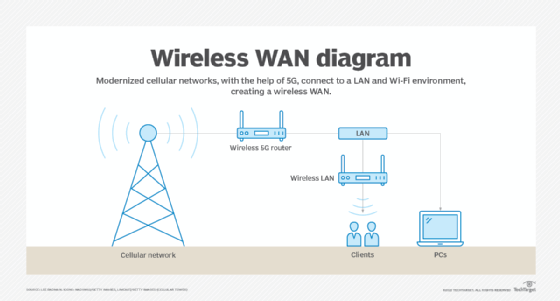
As wireless WAN matures, benefits and challenges emerge
[ad_1]
Wireless technologies pervade the nooks and crannies of daily life, from smart home links to satellite-based ISP connections. For many of us, Wi-Fi has become our main network access method, backed up by cellular broadband connections. It’s a wireless world in countless ways, and one of the more interesting applications is the wireless wide area network, or WWAN.
In general, wireless is about reducing costly wired network connections, getting connectivity to difficult locations and enabling endpoint devices to take advantage of new technologies. The WWAN paradigm conforms to that philosophy. When designed and used correctly, WWAN environments can offer impressive network reliability. But what exactly is a WWAN?
What is wireless WAN used for?
The wide area wireless network covers a few different operational goals. To most people, WWAN is the use of mobile broadband technologies to provide a foundational wireless network essentially anywhere in the cellular network providers’ coverage zones.
Backhaul to the internet uses 5G, for a simple example, to connect to a router that then feeds a LAN and Wi-Fi environment. From there, VPN or software-defined radio enhancements make a generic connection meet specific organizational requirements. This boosts the connectivity to an enterprise-grade level — at least for security and policy enforcement.
The wide in WWAN is significant because the areas covered are getting closer to global scale, thanks to the advances in cellular networks and high-speed satellite offerings. Compared with a decade ago, the lines on a WWAN diagram are getting as busy as enterprise LAN diagrams when it comes to far-flung failover connectivity and backup connectivity.

WWAN doesn’t have to use commercial carriers, despite that being the typical model. In addition, the idea of wide does not have a well-defined threshold. Yet, it’s bigger than LAN and sometimes overlaps with a metropolitan area network.
That said, WWAN can include private networks that include point-to-point, mesh and private cellular network components that span large areas. Likewise, a low-bandwidth, highly distributed IoT network covering an interstate highway or rail system could also be considered WWAN.
The benefits and risks of WWAN
The benefits of WWAN are probably obvious. Organizations could potentially access enterprise resources from more locations and extend high-bandwidth virtual interconnects via WWAN. But, like all things in networking, there is no totally free lunch. Among the tradeoffs are complexity, loss of control and central management of the entire network path, and performance variability.
Typically, enterprises own their network infrastructure, even when long-distance leased links are involved. The design, implementation and maintenance of the network infrastructure is within the organization’s control.
With WWAN, businesses need to trust the carriers to provide reliable networking topologies, unless building a private WWAN. In the WWAN model, it’s easy to appreciate not having to maintain the network for widely scalable connectivity. But, when connections are slow or disrupted, enterprises might not have the visibility to see where the problems lie. Instead of troubleshooting, network managers are calling providers hoping to find a sympathetic ear and technical expertise.
It’s worth noting that WWAN is, in fact, wireless connectivity, which always has different vulnerabilities from wired connections. Even when licensed frequencies are in play, the physics of wireless technology means that interference — whether it’s human-made or natural causes — is a potential problem over time.
Is WWAN viable?
The COVID-19 pandemic created legions of hybrid and remote employees who rely on the WWAN model to connect them to the corporate network. As carriers continue to modernize their networks with the advent of 5G, reduced latencies and increases in speed and capacity enable the WWAN model to gain market share as various technologies, including software-defined networking (SDN), are layered over it.
When implemented properly, WWAN is viable in several roles and will continue to garner interest as enterprise networks and their use cases evolve.
WWAN vendor Cradlepoint is arguably the standard-bearer for providing components like 5G routers that use WWAN for enterprise use. But the field is growing as traditional networking vendors embrace the opportunities that come with WWAN.
Whether a branch location is being turned up or a short-term event needs networking, making use of WWAN can be the difference between success and no network at all, especially in difficult-to-wire locations. Carriers are getting the message that flat-rate pricing and data pooling for multiple subscriptions help customers to consider WWAN as an affordable option versus “the meter is always running” paradigm of yesterday.
WWAN is a space to watch, especially considering evolving work models and the fast convergence of several technologies, including 5G, SDN and private cellular.
[ad_2]